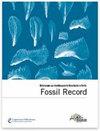The geologically oldest specimen of Pterodactylus: a new exquisitely preserved skeleton from the Upper Jurassic (Kimmeridgian) Plattenkalk deposits of Painten (Bavaria, Germany)
IF 2.1
4区 地球科学
Q1 PALEONTOLOGY
引用次数: 2
Abstract
Pterodactylus from the uppermost Jurassic of southern Germany represents one of the most iconic pterosaurs, due to its status of being the first member of the Pterosauria to have been described and named. During the early phase of pterosaur research, Pterodactylus was a wastebasket taxon containing dozens of sometimes distantly related assigned species. Decades later, a comprehensive revision of the genus significantly reduced the number of species. To date, only one species remains in the genus, Pterodactylus antiquus, although the referral of several specimens to this taxon and the taxonomic relationships of them is still debated. Thus far, the genus has been only reported from the Upper Jurassic Plattenkalk deposits of Bavaria, and all of these occurrences are Tithonian in age. Here we describe the first record of Pterodactylus from the Torleite Formation near Painten (Bavaria), which represents the first occurrence of the genus from the Kimmeridgian. The specimen is a complete, articulated and exquisitely preserved skeleton of a small-sized individual. Aside from its old geological age, it is a typical representative of the genus, greatly resembling other specimens from younger strata. Certain characters, such as the overall size, skull length, relative orbit size, and phalangeal formula indicate that the specimen from Painten represents a juvenile to young subadult individual, an ontogenetic stage rarely found among Pterodactylus specimens. The find significantly expands the temporal range of the taxon and represents one of the best-preserved specimens of the genus reported so far.地质上最古老的翼龙标本:上侏罗纪(Kimmeridgian)Plattenkalk Painten矿床(德国巴伐利亚州)中一具保存精美的新骨架
德国南部侏罗纪最上层的翼龙是最具标志性的翼龙之一,因为它是翼龙科第一个被描述和命名的成员。在翼龙研究的早期阶段,翼龙是一个废纸篓分类单元,包含数十个有时亲缘关系遥远的指定物种。几十年后,对该属的全面修订显著减少了物种数量。到目前为止,该属只剩下一个物种,即反曲翼龙,尽管将几个标本转介到该分类单元及其分类关系仍存在争议。到目前为止,该属仅在巴伐利亚上侏罗纪Plattenkalk矿床中有报道,所有这些矿床的年龄都是提香阶的。在这里,我们描述了第一个Pterodactylus的记录,该记录来自Painten(巴伐利亚州)附近的Torleite组,代表了该属首次出现在Kimmeridian。该标本是一具完整、有关节、保存精美的小型个体骨骼。除了其古老的地质年代外,它是该属的典型代表,与年轻地层的其他标本非常相似。某些特征,如整体大小、头骨长度、相对眼眶大小和指骨公式,表明来自Painten的标本代表了一个幼年到年轻的亚成年个体,这是翼龙标本中很少发现的个体发育阶段。这一发现显著扩大了该分类单元的时间范围,是迄今为止报告的该属保存最完好的标本之一。
本文章由计算机程序翻译,如有差异,请以英文原文为准。
求助全文
约1分钟内获得全文
求助全文
来源期刊

Fossil Record
PALEONTOLOGY-
CiteScore
3.60
自引率
7.10%
发文量
18
审稿时长
14 weeks
期刊介绍:
Fossil Record (FR) is the palaeontological journal of the Museum für Naturkunde Berlin. This journal was founded in 1998 under the name Mitteilungen aus dem Museum für Naturkunde Berlin, Geowissenschaftliche Reihe and appears with two issues each year. Fossil Record publishes original papers in all areas of palaeontology including the taxonomy and systematics of fossil organisms, biostratigraphy, palaeoecology, and evolution. All taxonomic groups are treated, including invertebrates, microfossils, plants, and vertebrates.
 求助内容:
求助内容: 应助结果提醒方式:
应助结果提醒方式:


